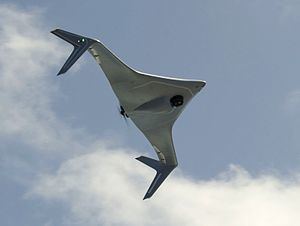Top speed 166 km/h Length 2 m | Wingspan 4.3 m | |
 | ||
Northrop grumman bat uav
The Bat is a medium-altitude unmanned air vehicle sea and land based originally developed for use by the United States Armed Forces by . Designed primarily as an intelligence "ISR" gathering tool, the Bat features 30 lb payload capacity that is unmatched in a 10 ft wing span.
Contents
- Northrop grumman bat uav
- Northrop grumman bat 12 flying wing uav
- Characteristics
- Uses
- Specifications Bat UAS
- References
Northrop Grumman received design and marketing rights to sell the Killer Bee which was renamed the Bat UAS in April 2009.
The Bat UAS was redeveloped to increase payload carrying capacity and extend range. The latest variant offered for sale by Northrop Grumman has a wing span of 14 feet and can carry up to 100 pounds of payload. The Bat "14" UAS has a maximum altitude of 17,000 feet above sea level and a maximum endurance of 18 hours.
On August 12, 2011 Northrop Grumman was awarded $26,178,369 on a cost-plus-fixed-fee contract modification basis for Sand Dragon B Tier II UAVs for detecting IEDs and roadside bombs.
Northrop grumman bat 12 flying wing uav
Characteristics
The blended wings merge with the fuselage into a single airfoil to reduce aerodynamic drag, improve fuel economy, and increase flight endurance. Made largely of composites, including epoxy/carbon fiber and fiberglass, the airfoil is rigid, providing structural efficiency and stiffness, reducing materials and manufacturing costs. With net hooks in the nose and a rear push propeller, the craft lands in a mobile retrieval net.
The current Hirth engine with 5 bladed propeller provides a flight time of up to 18 hours. The Bat is designed to have a lower than average visual and radar cross-section profile. A heavy fuel engine design is also available for ease of environmental integration.
The payload capabilities consists of, for example, still image and real time video cameras, EO/IR and SAR sensors, Kestrel MTI, laser range finders, laser designators, Infra-Red cameras, communication relays, IED Detection, Radar Jamming EW, chemical and biological detection systems, Psy Ops, and flare dispensers.
Uses
The Bat UAS has the ability to carry numerous types of payloads for collecting intelligence, including still image and real time video cameras, EO/IR and SAR sensors, laser range finders, laser designators, Infra-Red cameras, communications relay equipment, chemical, biological, and IED detection systems and flare dispensers. The Bat (formerly KillerBee) series is planned for commercial sale to support private security surveillance, and as a means to monitor pipelines, power lines, Border Protection as well as weather phenomenon.
Specifications (Bat UAS)
General characteristics
Performance
